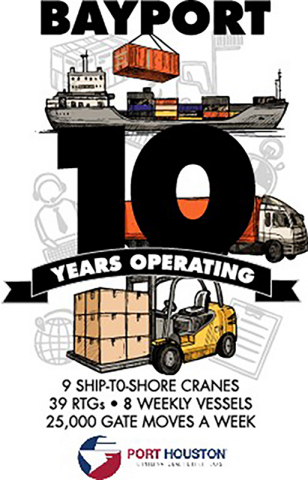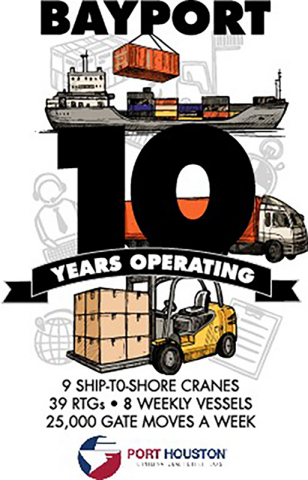HOUSTON--(BUSINESS WIRE)--February marked the tenth anniversary of the opening of the Bayport Container Terminal.
Bayport was built to handle the increase in container cargo driven by the tremendous growth in Texas. It is considered to be one of the most modern and environmentally sensitive facilities in the United States.
Port Houston owns and operates both Bayport and Barbours Cut Container Terminals – together these two terminals are responsible for handling nearly 70 percent of all of the container cargo business along the Gulf Coast. The Barbours Cut Container terminal, which will celebrate its 40th anniversary of operations this summer, was the first container terminal to serve the gulf.
Bayport terminal currently has nine ship-to-shore cranes and 39 RTG yard cranes, averaging eight weekly vessel calls and 25,000 truck gate moves a week. When fully developed, this state-of-the-art terminal will have a total of seven container berths with the capacity to handle 2.3 million TEUs in a complex which includes 376 acres of container yard and a 123-acre intermodal facility.
The terminal’s sister facility, the Bayport Auto Terminal, opened for business in November 2016. Originally used for cruise operations, it is now the site of import operations readying new inbound vehicles for auto distribution.
Port Houston has deepened channels adjacent to Port Houston’s Barbours Cut and Bayport container terminals to match the Houston Ship Channel, enabling ships with drafts up to 45 feet to call at both terminals (as well as the adjacent private facilities). The $85 million self-funded project also widened and realigned the channels to better accommodate larger ships.
The most recent economic impact study by Martin and Associates showed that the facility helps generate more than 32,000 jobs and adds approximately $1.6 billion to the Texas economy through wages and tax revenues.
The terminal’s environmental benefits include the preservation of 956 acres of diverse coastal habitat, 200 acres of new marshlands, 173 acres of created or enhanced wetlands, and the preservation of a 128-acre buffer zone.
“We are proud of the growth of the Bayport Terminal since its opening a decade ago. Its success and positive impact on jobs and the economy are due to the leadership of our Port Commission, staff, and all of our partners,” said Port Houston Executive Director Roger Guenther. “There is an amazing future ahead of us that will bring tremendous opportunities as well as challenges that we will continue to tackle, to keep Port Houston and our busy waterway at the forefront of prosperity. We are ready for the future.”
A social media campaign highlighting interesting facts and statistics regarding the Bayport terminal complex commemorates this special milestone in Port Houston’s history.
About Port Houston
For more than 100 years, the port has owned and operated the public wharves and terminals of the Port of Houston – the nation’s largest port for foreign waterborne tonnage and an essential economic engine for the Houston region, the state of Texas, and the nation. It supports the creation of nearly 1.175 million jobs in Texas and 2.7 million jobs nationwide, and economic activity totaling almost $265 billion in Texas – 16 percent of Texas’ total gross domestic product – and more than $617 billion in economic impact across the nation. For more information, visit Port Houston’s website at: www.porthouston.com.




